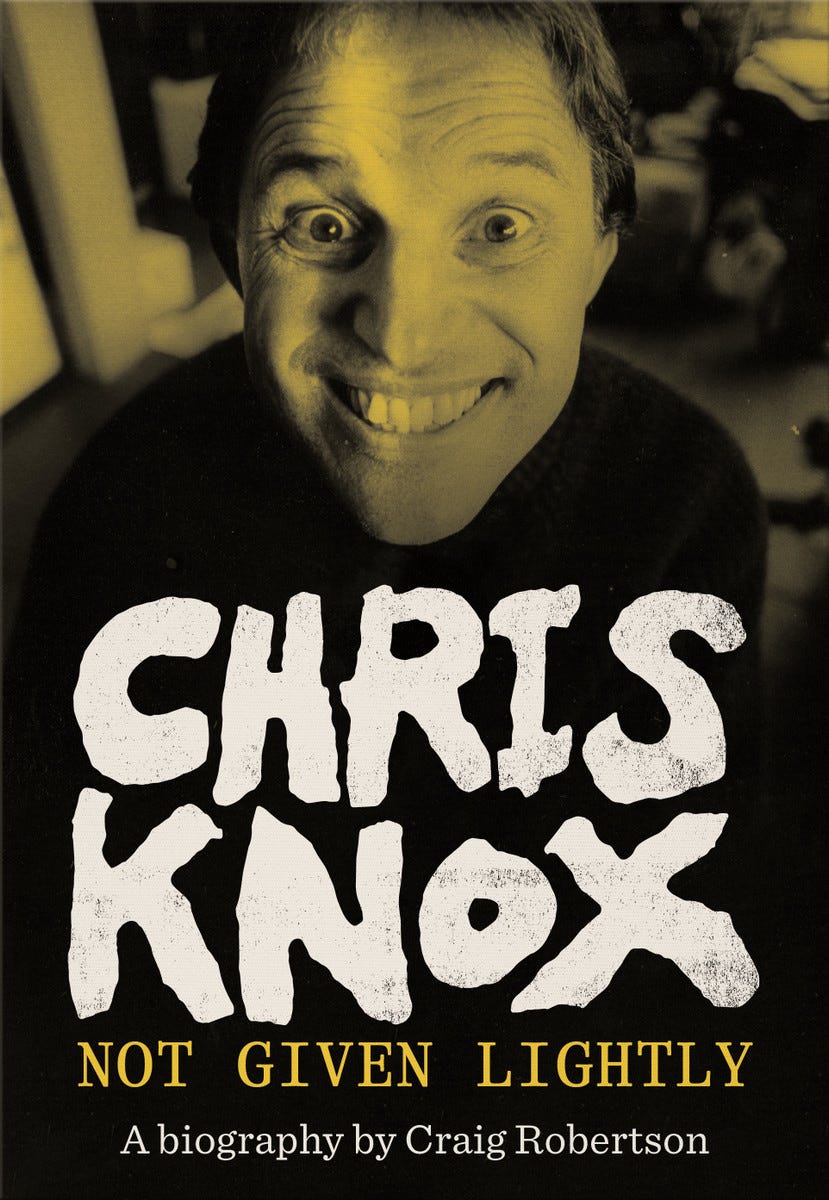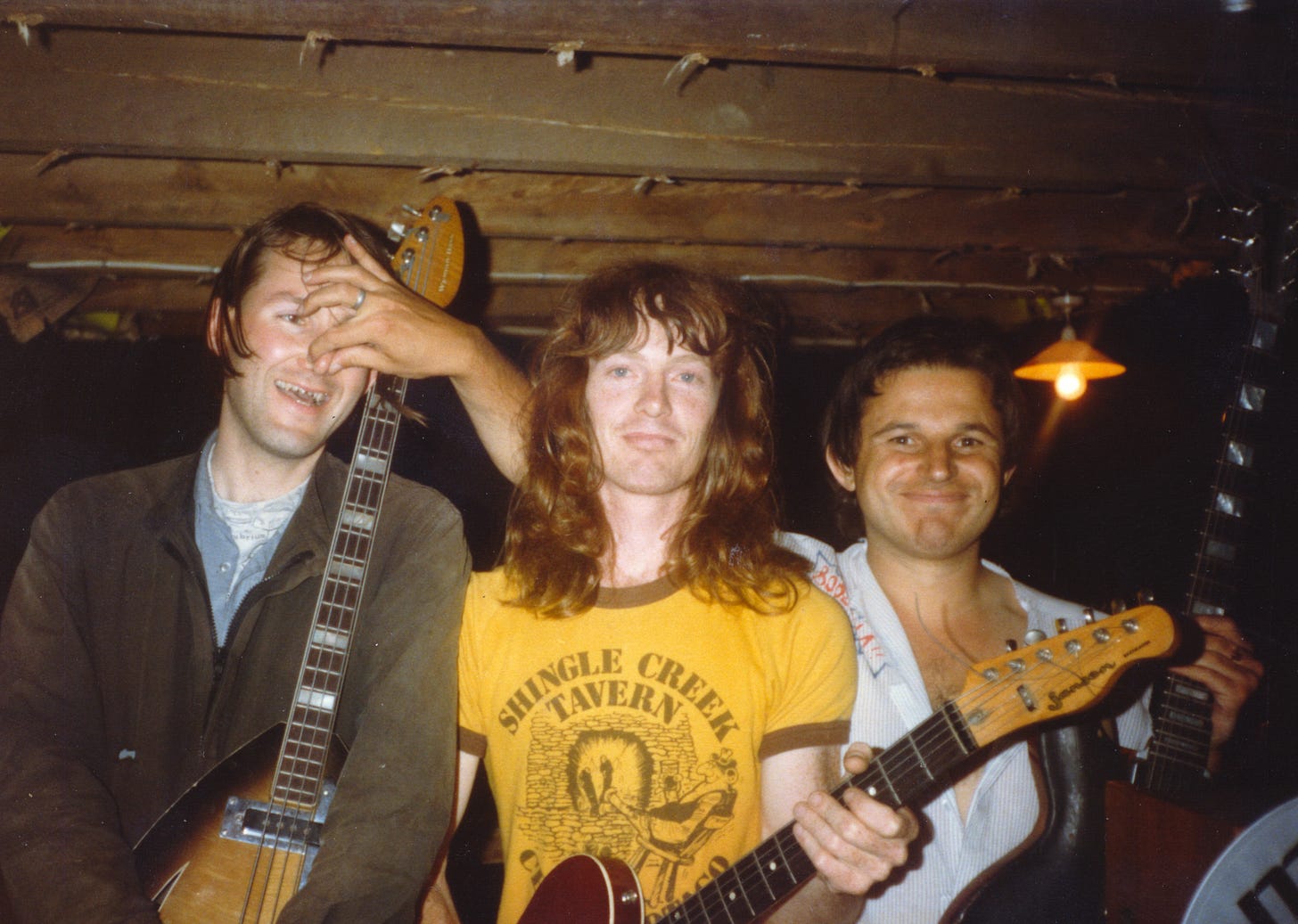'Cause, when it all comes down to dust
Can I say that Craig Robertson's bio of Chris Knox is anticipated? It is, and it's arrived.
Chris Knox: Not Given Lightly – Craig Robertson (AUP, 2025)
One of my favourite Toy Love memories was the rare moment they’d sway (a Toy Love gig always involved a lot of swaying along a wide and unpredictable musical and visual pathway) away from their glorious aural assault of originals and drop in a perfectly selected and timed cover version. It both gave the crowd a moment’s respite from the intensity and sometimes added big humour. The bubblegum classic (can we use that word with the efforts of the Kasenetz-Katz circus?) ’Yummy, Yummy, Yummy’, segueing into Dylan’s ‘Positively 4th Street’ was the latter. My favourite Toy Love cover, though, was Badfinger’s power-pop classic ‘No Matter What’, but it was rarely played. I have no idea why.
Which brings me to Chris’s 2005 album with his then-new band, Chris Knox And The Nothing. It was, and I hope I’m not offending Chris, his Badfinger album, and I loved it very much for that reason when it came out. I’m not saying or wanting to imply that it was Chris aping the wonderful (although blighted–the story has been well told) Welsh band, but like Pete Ham and co, Chris Knox And The Nothing wore its influence proudly, and that influence was Lennon-McCartney, in this case leaning very, very strongly towards the former (though the brass and string flourishes Chris adorns some of these songs with are very Paul). And as with Badfinger, it did so in grand style. I loved Chris Knox And The Nothing and played it obsessively. It arrived at the same time I discovered some of Macca’s 90s music, and as I drove around my new home in Bali with the windows down, I loudly broadcast it to the tropical island. That was then, and over the years, I’d largely lost the album, mainly because I rarely listen to music digitally now, and that’s how this record exists now. I’ve never owned a CD of it, and I lost my paid download long ago.
There was a second album, A Warm Gun, where Chris dropped his own name and subsumed himself as part of the band; a more confronting album musically, more Plastic Ono Band meets the Velvet Underground than Revolver and lyrically very exposed, as the Barbara Ward/Chris Knox relationship appeared to be troubled. I loved that too, just not quite as much. (Maybe that’s changing at the moment.)
Why am I writing about these albums now? Craig Robertson’s new book on Chris is the reason. The last few pages are about The Nothing, and the albums came rushing back. I’ve been playing these records (I wish they were records, actually: vinyl, please someone, maybe Ben and Roger?) continuously in the past few days and seem to have fallen in love with them all over again.
Craig’s book tells us that sales of both were negligible, but the second even more so, since Chris seems to have forgotten to sort out the promo side of things, something you could argue is very Chris, but that needs to push aside the extraordinary coordination and drive that a career such as his required. He just had other things to do. Not Given Lightly also tells us that The Nothing was intended to be a more long-term project, with touring and more recording planned. It was another step in that vast body of artistic invention that is Chris Knox. Sadly, one that came to a halt on 11 June 2009.
Except it didn’t, one of the things this book reminds the reader is that Chris has been very active in the decade and a half since, both musically and visually (he’s continued to paint and draw, relearning his technique with his left hand and has artwork for sale). He even pushed for a Toy Love reunion, but found that a hard sell.
One of the funniest stories in a book full of humorous tales, that sometimes make you laugh out loud, is the one at the very end, about the visiting American band Pavement, famously very much influenced by Chris, who, having visited him post-stroke, was ushered into his art room. Chris pointed to his works and said, “Buy”. When there was no response, he repeated, “Buy”. The band thought he was saying “Bye” and left. [I hope that’s not an ending spoiler, but there’s more context I’ve left out, and my school English teacher, Merv Nixon, used to tell us you always read the last page first.]
This is such a remarkable book, albeit one that I approached a little warily. Chris’s body of work is expansive, and it redefines the much overused term multimedia (which still feels more comfortable than the straitjacketed *multidiscipline* academics lean towards). That body of work could have easily devoured the book, pushing it into an academic cul-de-sac. Instead, Craig wisely uses his work and its evolution to tell the human story of one of our greatest creative eccentrics, a true, determined and driven original whose life has not only impacted but changed almost every art it’s encountered, often at a granular level. The music industry (he hates the phrase, I’m ok with it as it does work even in a cottage/diy way) in Aotearoa was forever altered by Chris’s experience when he came face to face with the worst of it with Toy Love in Australia and then channelled that experience into his next musical outlet, Tall Dwarfs, and the tiny label he adopted in Christchurch with just a couple of cool singles under its belt. It’s perhaps worth considering what might have happened to Roger’s start-up (if you can stretch that description to cover a dusty office that overflowed into a bar called Warners at times) if Chris and Doug Hood hadn’t allied themselves with Flying Nun. And vice versa.
While I’m very proud of having released the first Tall Dwarfs record (all we did was provide an outlet and pay the tab when Chris blew the speaker at Mandrill mastering it), it was Roger who gave Chris, both as a half of a duo with Alec, and as a solo act, the unrestricted outlet for wherever–and whatever and whenever until Mr Warner gobbled the label up in 2005–his musical whims took him. It was Flying Nun’s growing international presence and the fact that his name was integral to the label’s profile that helped Chris establish himself as a global name, lovingly and very respectfully seen outside the mainstream worldwide as the spiritual godfather of inventive and uncompromising lo-fi. Larger than life, perhaps, except the real thing was actually larger than anyone offshore could probably guess. We knew.
At a 1998 show supporting Blondie in Paris’s Bataclan, the crowd went “apeshite” for the grandmeister of alt. Or so Chris proudly tells us.
That’s in Not Given Lightly (a title the author explains he reluctantly agreed to but came to understand was right), as is a detailed and affectionate overview of the seemingly endless catalogue of other Knox creative constructions: his videos, artworks, writings, reviews, animation, his production for others, and, especially, his cartoons. While the independent music world loved Chris’s sounds and words and how he shared them with us, we in Aotearoa also experienced the rest. For many of us, Max Media, Extra, Pop Vulture, his TV reviews, and much more were appointment stuff. We bought magazines just to get them, or flicked to Max in the dairy.
However, it’s more than that: in his jandals and scruffy shorts, he was at the local shop, he’d arrive randomly on a stage (and often perform just as randomly), his opinions were kinda right, and we nodded our heads, people knew where he lived and said hello in he street. He was and is a cultural touchstone you could almost touch; the fact that he (and Alec) made records like that and drew like that meant we could too. It’s difficult to recall a time when Chris wasn’t quietly grinning just out of sight, waiting to drop another withering few words graphically or pass an appropriately wry comment on the screen. One of the parts of the book I loved most was when his parents, in Invercargill and still festering somewhat that their son hadn’t quite achieved the things they’d hoped for (I knew that feeling), finally *get* Chris Knox with much pride and understand his place in our culture.
For all that, Craig’s book isn’t a hagiography or close to it; he’s a subjective arm’s-length fan, not a critic, and that makes this immensely readable. It’s rarely swamped in minutiae (although there is plenty of it), and is neither overly academic nor dense. It’s a compulsive page-turner (it’s a cliche, but it works here) that had me sitting up half the night; one that I finished in less than five days. I doubt Chris would accept anything different. It’s authorised, in that the author was granted full access over a very long period of time and trusted. Still, I imagine Chris, Barbara, and their kids will be pleased that it’s both definitive and populist in the very best possible way.
It’s also a wonderful book to hold and look at. To hell with ebooks, this is such a terrific artefact, from the textured sleeve, to the fabulous cover shot and perfect font, to the generous amounts of often unseen imagery inside. And as much as Chris has always seemed to value some disposability in his work–one album flows from the last, his cartoons last an issue–it’s a book for the ages, just as Chris’s beloved Plastic Ono Band and Velvet’s albums are.
On a personal level, my life was forever transformed by that quartet, later quintet, from distant southern lands most of us had never seen, who stepped into my small record shop in Parnell on 18 September 1977, and then forcefully educated a hesitant Auckland punk establishment (we were all between 15 and 20, so much for establishment) about songcraft and presence. Without that, AK79 wouldn't have existed, and Propeller Records may not have happened as a result.
I thought I’d finish by saying (and I’m nowhere near the first to do so, I know), how much I rate the continuing flow of immensely readable, but still historically invaluable and scholarly Aotearoa music and related books from Auckland University Press. It began in 2010 with Chris Bourke’s Blue Smoke (which surely needs a reprint) and hasn’t really stopped since. Thanks, Sam.
Almost done.
Finally, Peter McLennan has just digitised and made his neat 1995 half-hour documentary on Chris online for the first time, which he made when he was studying at Auckland University. It’s really very good. Chris talks about Chris:





Its always possible to blow a speaker..
Great review. I'll have to get a copy of the book next time I'm back in Aotearoa. One of my abiding memories of Chris is his live performance at the Nitpickers' Picnic during my first year at Auckland University in 1985 (although I'm not 100% sure I have the event name and year correct). And you reminded me of the first time I ever heard of the existence of Chris Knox (although I was yet to hear his music). In 1979, when I was in form 2, my sister briefly went out with a boy in the 7th form, two years ahead of her. He used to bring around all sorts of amazing records, and I was greatly influenced. Anyway, they and their friends went off to Sweet Waters and when they returned the boyfirend was raving about this crazy vocalist leaping all over the stage. Yes--Chris Knox from Toy Love.